At some point, literally by chance, I reached a parking lot not far from the main road that I took on my way from Rethimno to the south of Crete. I got out of the car and first paid attention to a building which I later realised was the Ossuary of the Victims of 1866. Then on the opposite side I noticed a couple of tourist coaches parked in that spacious lot and only then I started to realise that I actually came to a site that seemed important on tourist maps, but I still had no idea what this was all about.
I have already explained in the previous sequel how this happened. Briefly, a couple of days earlier I had decided to rent a car and was not prepared at all for such way of travelling around the island (in terms of the possible places of interest that I could come across while driving), planning only to move from one big town to the next.
When I left Rethimno on this day, in one place I noticed a brown sign beside the road, that is usually called the “tourist sign,” and I turned there. The sign pointed at something quite different (the way to Ancient Eleutherna), where I even did not go in the end, but I just stopped in this parking lot that was some hundred metres away from the main road.
As it turned out, I actually came to the historic Arkadi Monastery.
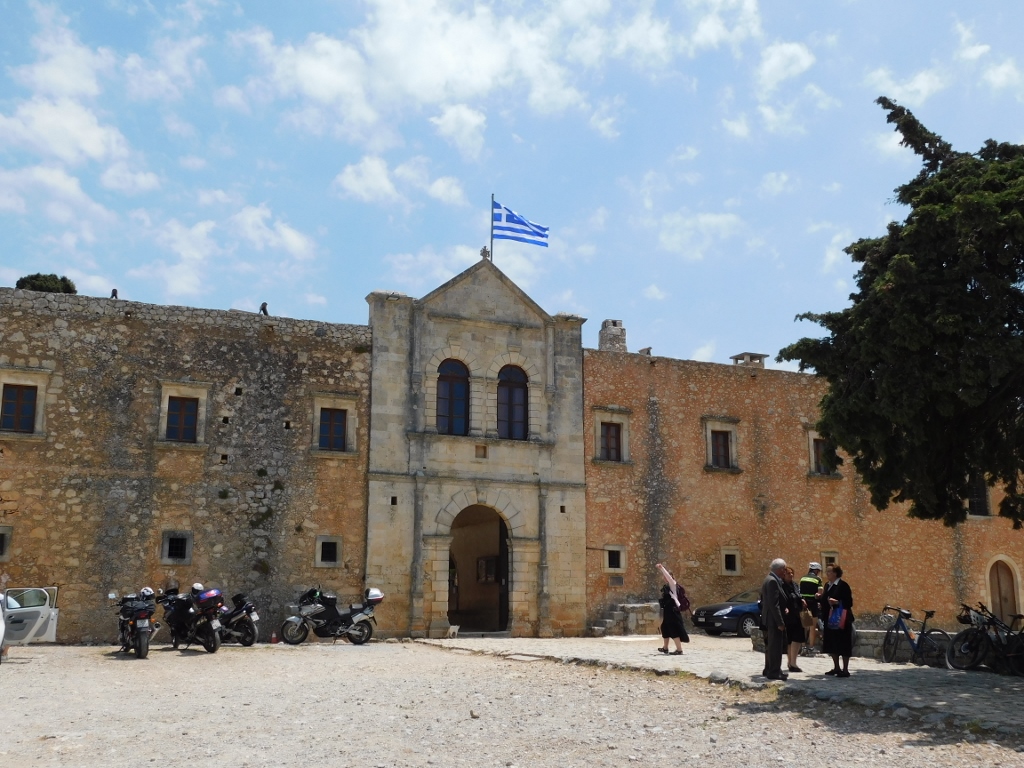 Arkadi Monastery, the front facade
Arkadi Monastery, the front facade
Since I knew nothing about this place and I saw the facade that reminded me of a fort, thus making me think this was a military facility, I actually did not know what to expect. I walked through the gate, bought a ticket and when I entered the courtyard I almost fainted... with absolute delight. There, in front of me, like an apparition, a magnificently beautiful church appeared before my eyes, not even remotely resembling the strict architecture of the exterior facade of the monastery.
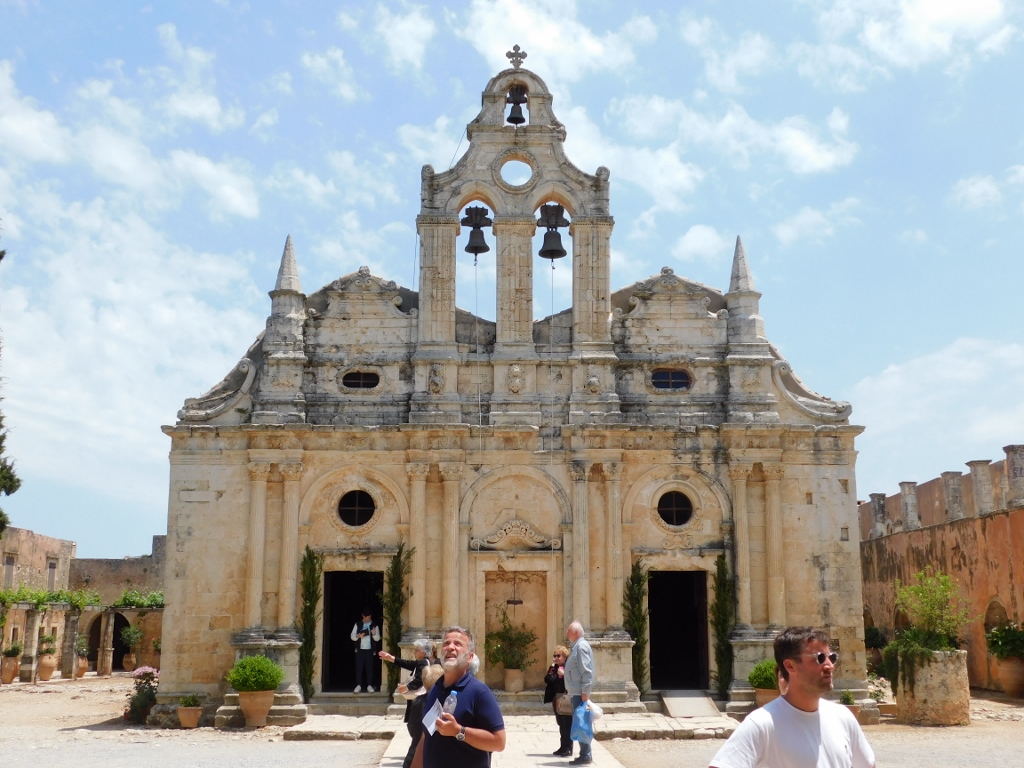 Arkadi Monastery, the church
Arkadi Monastery, the church
It is not known when the monastery was founded, but the impressive two-nave church that dominates the entire site dates back to 1587. Its facade was made in a style that combines elements of Renaissance and Baroque, with the triple belled tower standing out in particular.
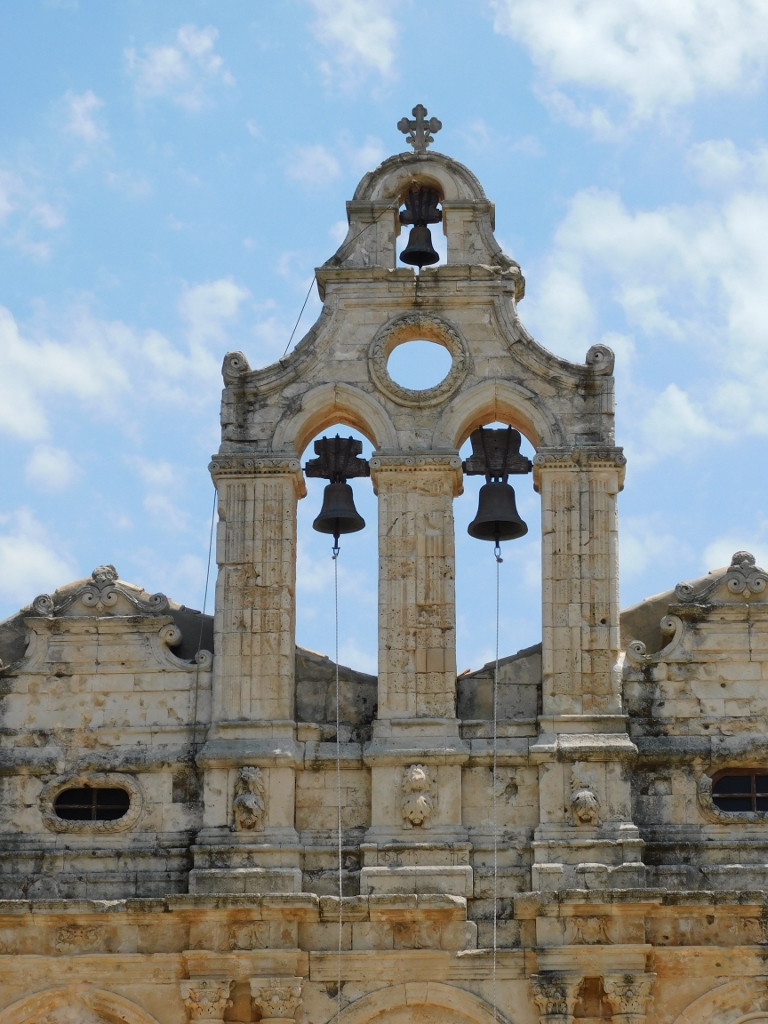 Arkadi Monastery, the church, a detail
Arkadi Monastery, the church, a detail
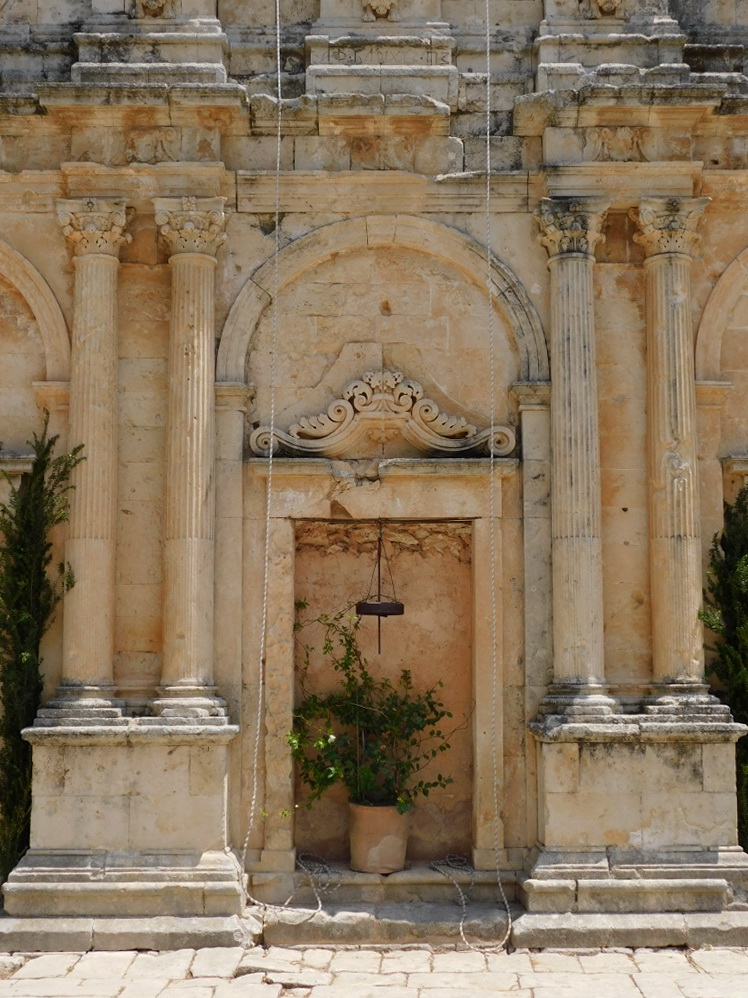 Arkadi Monastery, the church, a detail
Arkadi Monastery, the church, a detail
 Arkadi Monastery, the yard and the church
Arkadi Monastery, the yard and the church
The church, or rather the katholikon, meaning the main church of a monastery, is dedicated to the Transfiguration of Our Saviour, as well as to St. Constantine and St. Helena. When it was built, it actually replaced the earlier, smaller church from the 13th century.
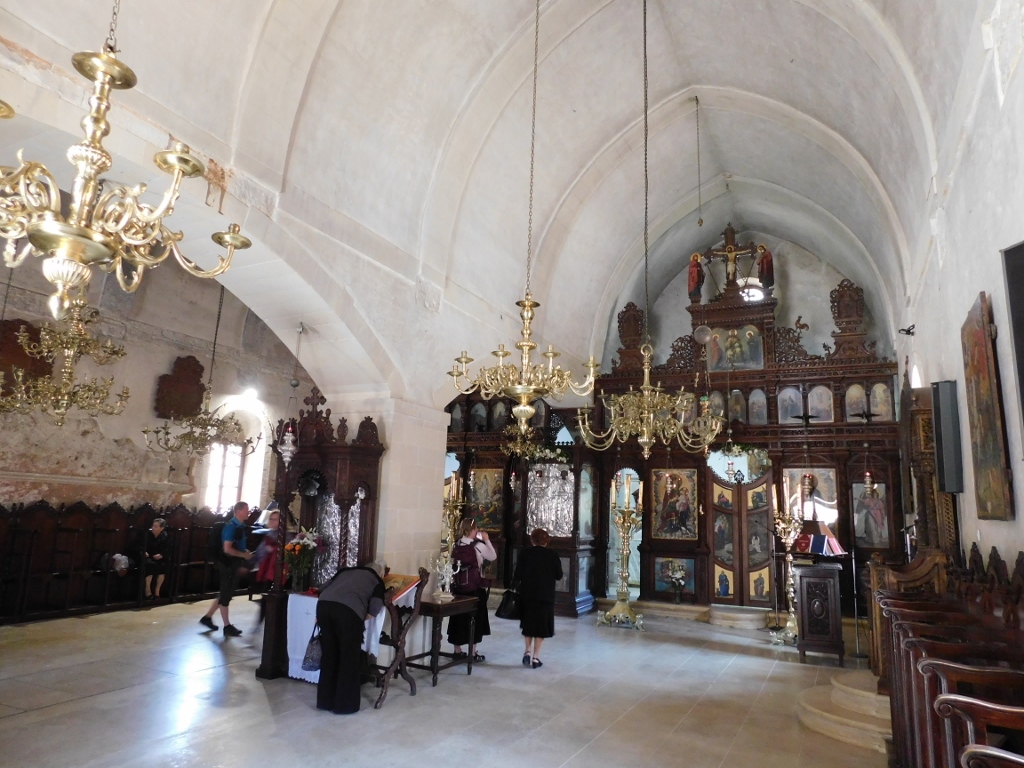 Arkadi Monastery, the church, a detail
Arkadi Monastery, the church, a detail
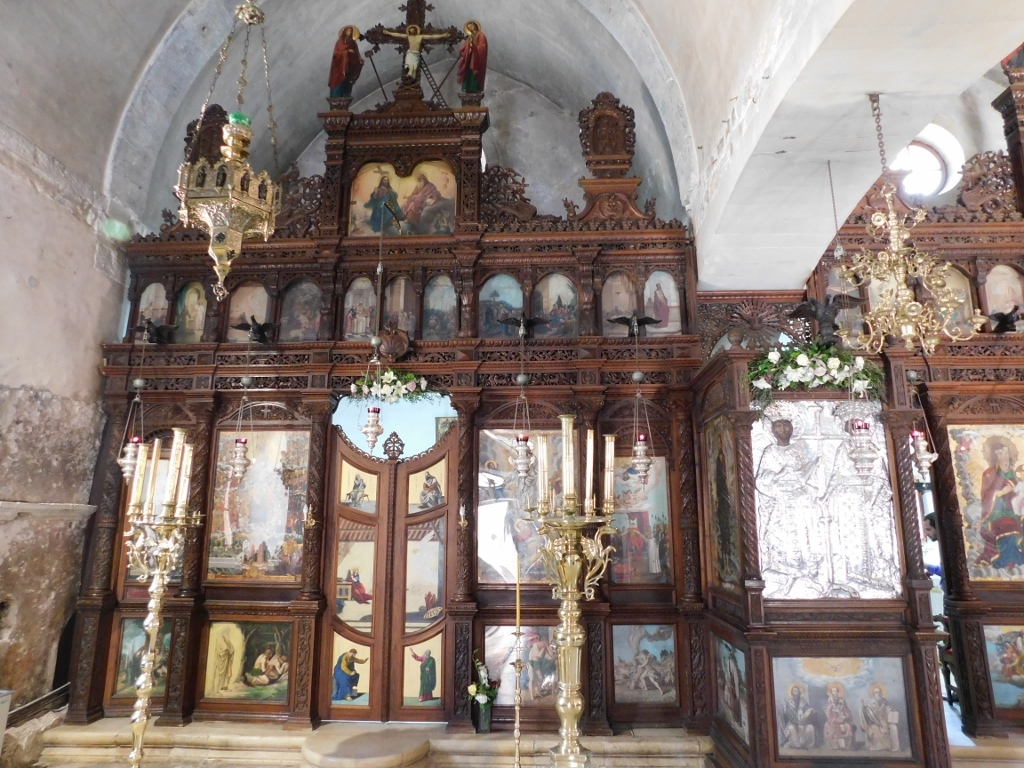 Arkadi Monastery, the church, a detail
Arkadi Monastery, the church, a detail
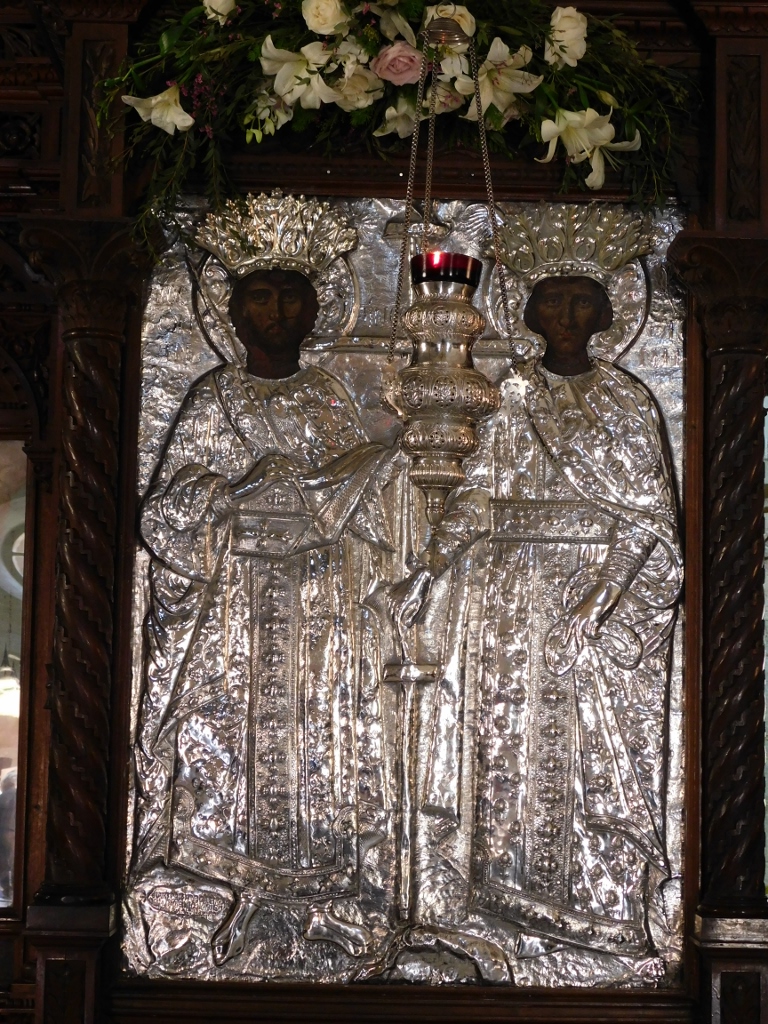 Arkadi Monastery, the church, a detail
Arkadi Monastery, the church, a detail
When I got out of the church, right in front of me I saw the West Gate through which I actually entered and which was built in 1870 in order to replace the original one (from 1693) that was destroyed during the Ottoman assault on the monastery in 1866. I have already written about this assault in the previous sequel of my travel stories.
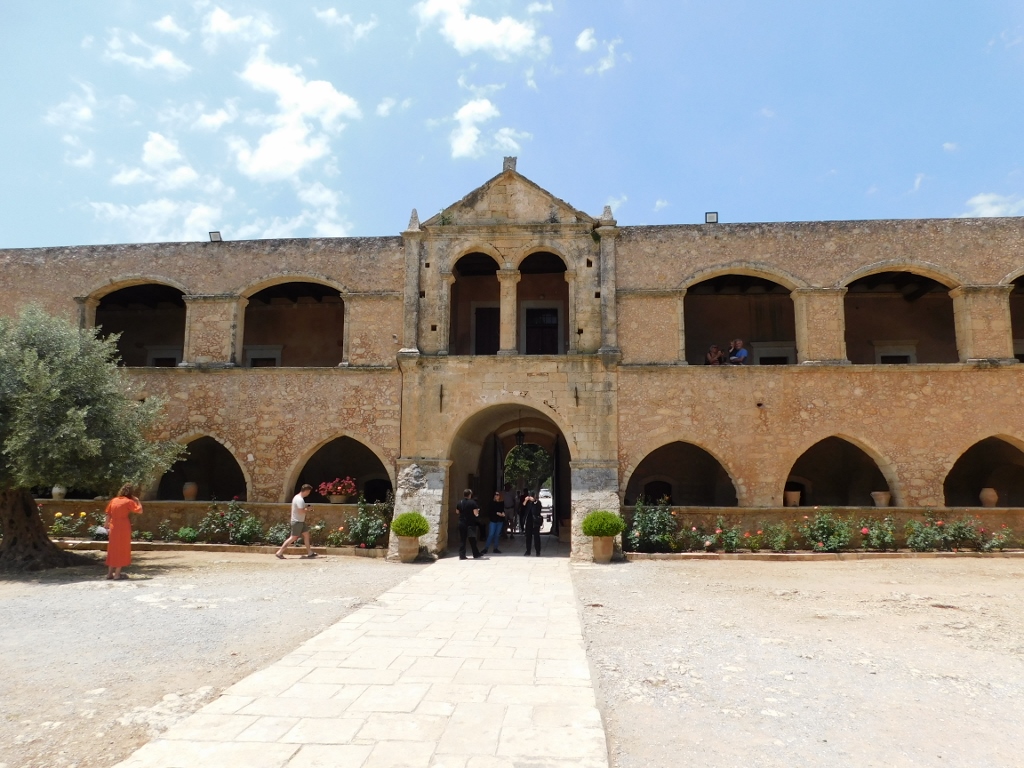 Arkadi Monastery, the West Gate
Arkadi Monastery, the West Gate
Then I climbed a flight of stairs leading to an art gallery that is located on the first floor on the south side of the monastery from where I had a fine view at the churchyard.
 Arkadi Monastery, the West Gate, to the left, and the church, to the right
Arkadi Monastery, the West Gate, to the left, and the church, to the right
By the way, the ground plan of the monastery is in the shape of an almost rectangular parallelogram, with a perfect orientation – the front facade of the church faces west.
After this, I got back to the ground level, also on the south side, where there is a museum with different exhibits. Some of them date back to the period when the monastery was founded, while the more recent ones come from the end of the 20th century.
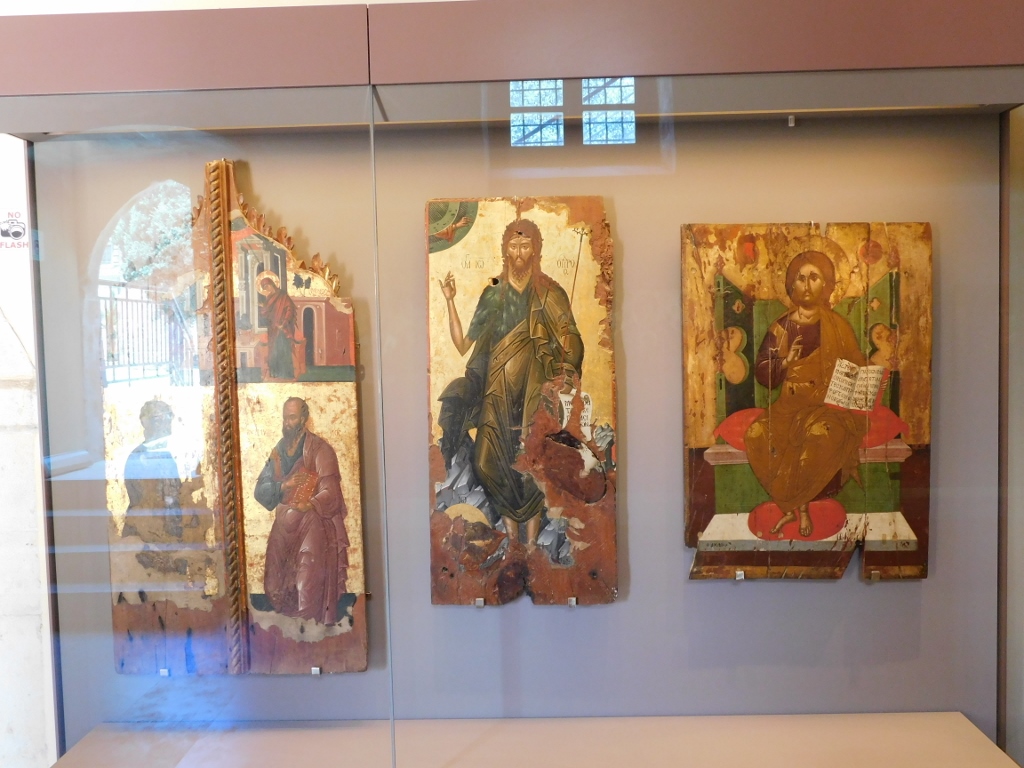 Arkadi Monastery, the museum, a detail
Arkadi Monastery, the museum, a detail
And yet, no matter how nice and interesting the exhibits were, my attention was unavoidably drawn to the church from whichever angle I looked at it. Meanwhile, most of the visitors had left the churchyard and then I liked it even more to take photos.
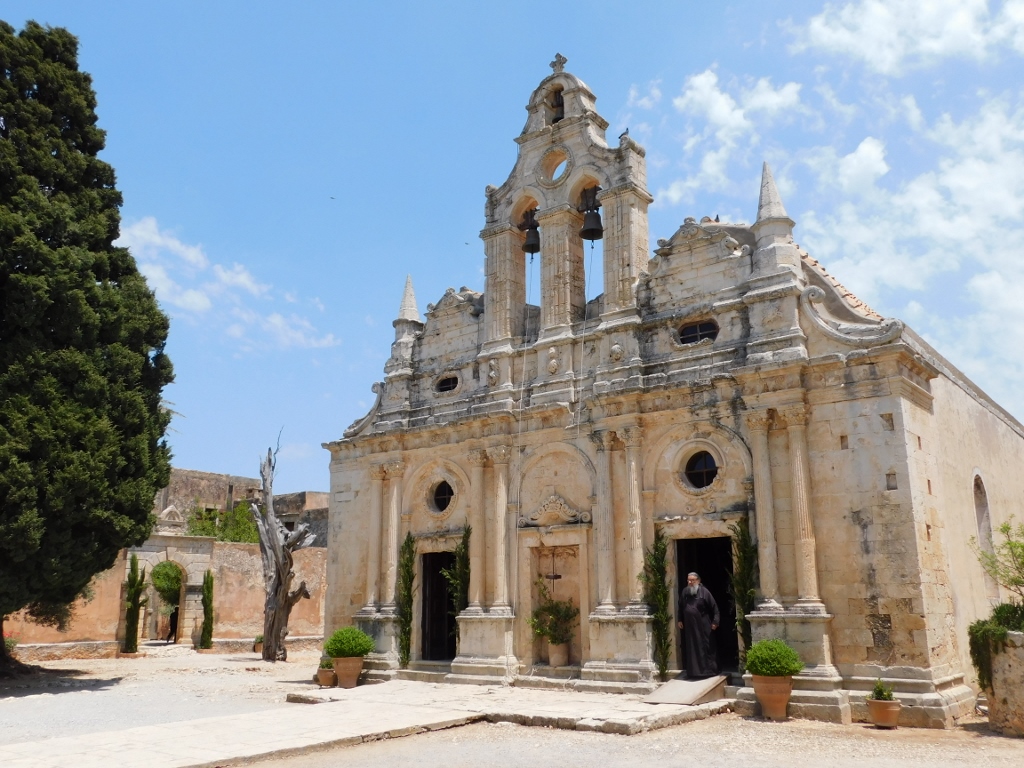 Arkadi Monastery, the Katholikon
Arkadi Monastery, the Katholikon
To the left of the church in the photo above, it is possible to notice a completely dried out tree. It was not left there just because somebody was too lazy to remove it. On the contrary. The tree is a witness of sorts to the, to put it mildly, dramatic events in November 1866. This is a cypress in which it is still possible to see a bullet that got stuck there during the battle.
I was now determined to deal a little more with various segments of the monastery and thus from the churchyard I moved to the north section where I visited a few parts.
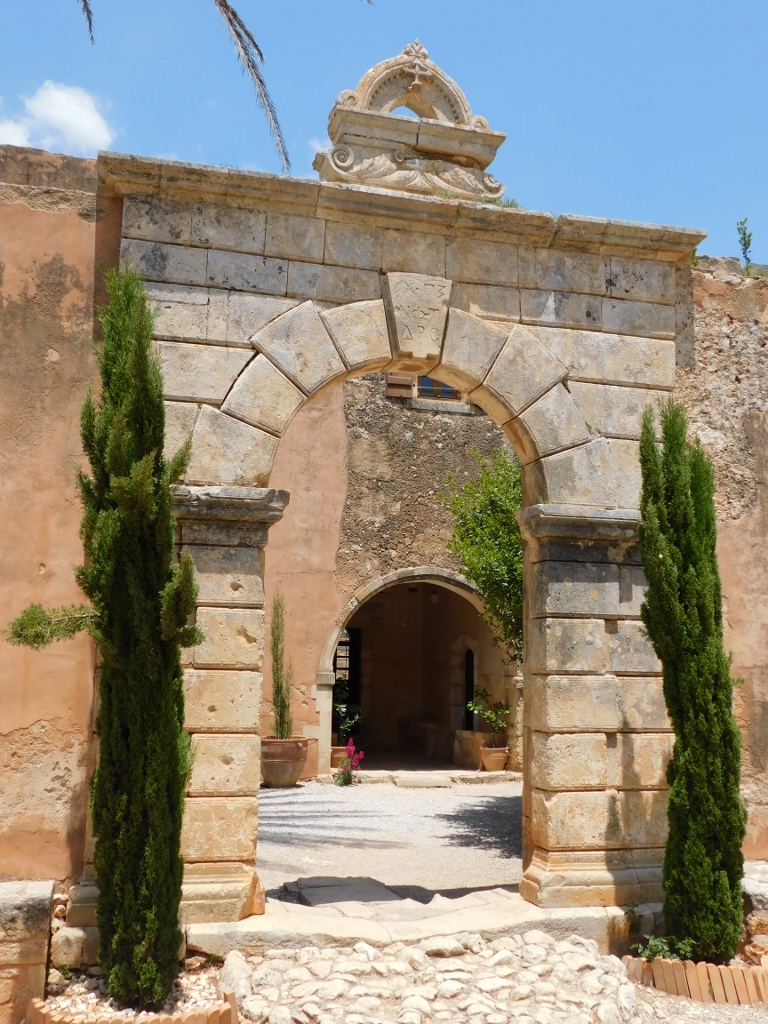 Arkadi Monastery, north gate leading out of the churchyard into a smallish courtyard
Arkadi Monastery, north gate leading out of the churchyard into a smallish courtyard
First I got to the Historic Refectory from 1670. In November 1866, the Ottomans killed 36 brave rebels here.
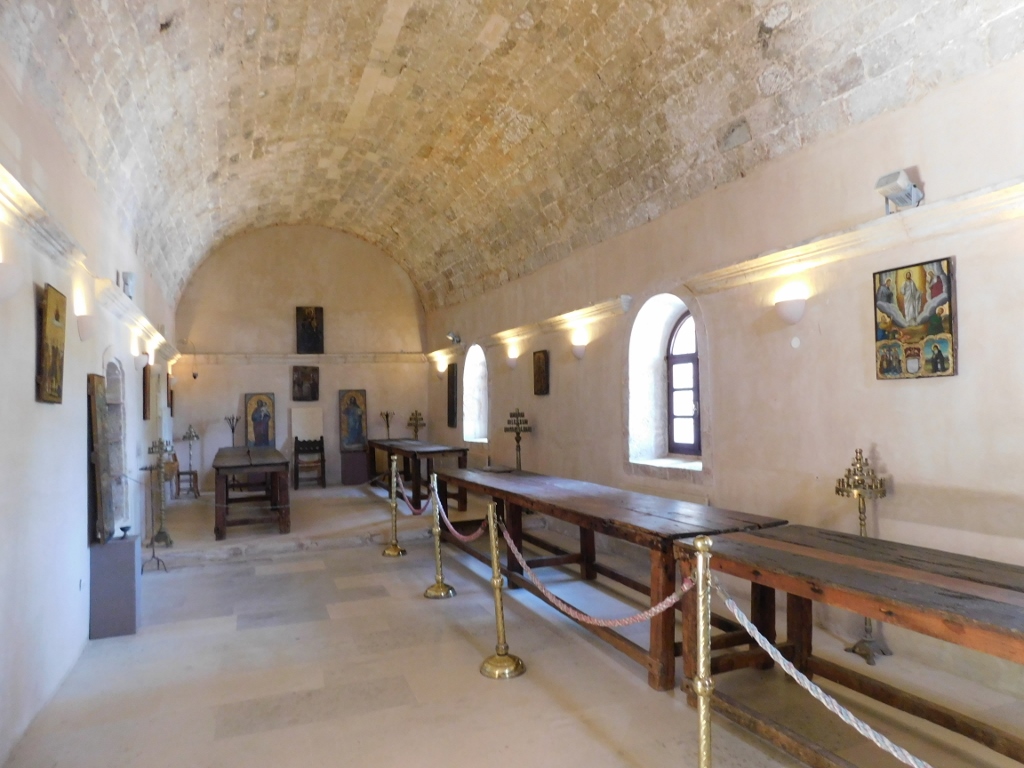 Arkadi Monastery, the Historic Refectory
Arkadi Monastery, the Historic Refectory
In this part of the monastery there is also the Chapel of St. Arkadius which I visited briefly before returning to the inner courtyard behind the north gate in order to move from there to the Cellars where food used to be distributed to workers, pilgrims and the poor. Nowadays, this is a small exhibition area, while a door leads to a monastery’s shop.
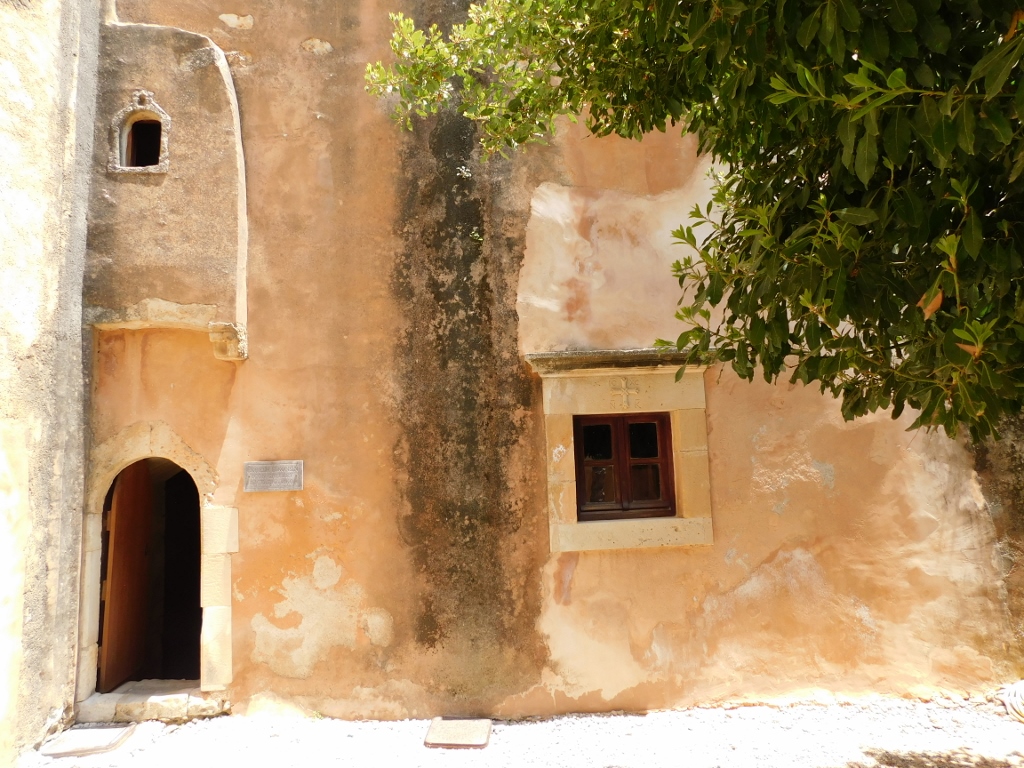 Arkadi Monastery, a detail
Arkadi Monastery, a detail
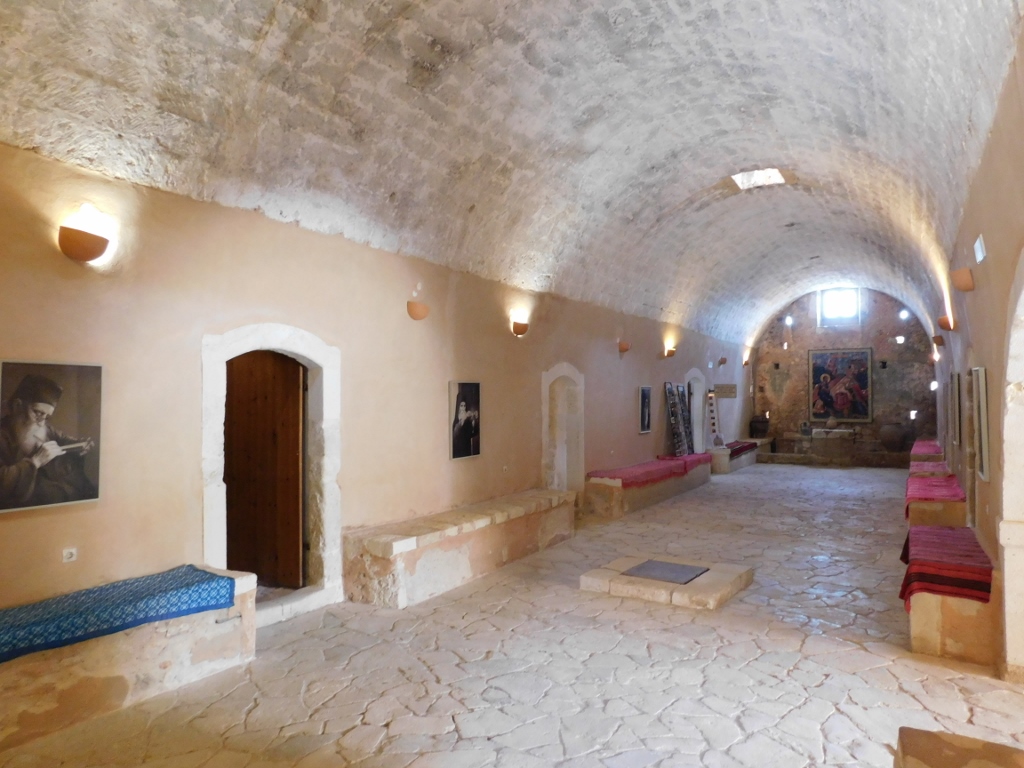 Arkadi Monastery, the Cellars
Arkadi Monastery, the Cellars
Now I went to the Powder Magazine where originally, before the 1866 uprising, there used to be a wine cellar. When the uprising started, this was the place where the ammunition was stored and consequently on 9 November 1866, the rebels blew up this whole area in order not to fall alive in the hands of the Ottomans. As a memory to this event, the area of the powder magazine has never been fully restored and a roof has never been constructed here again.
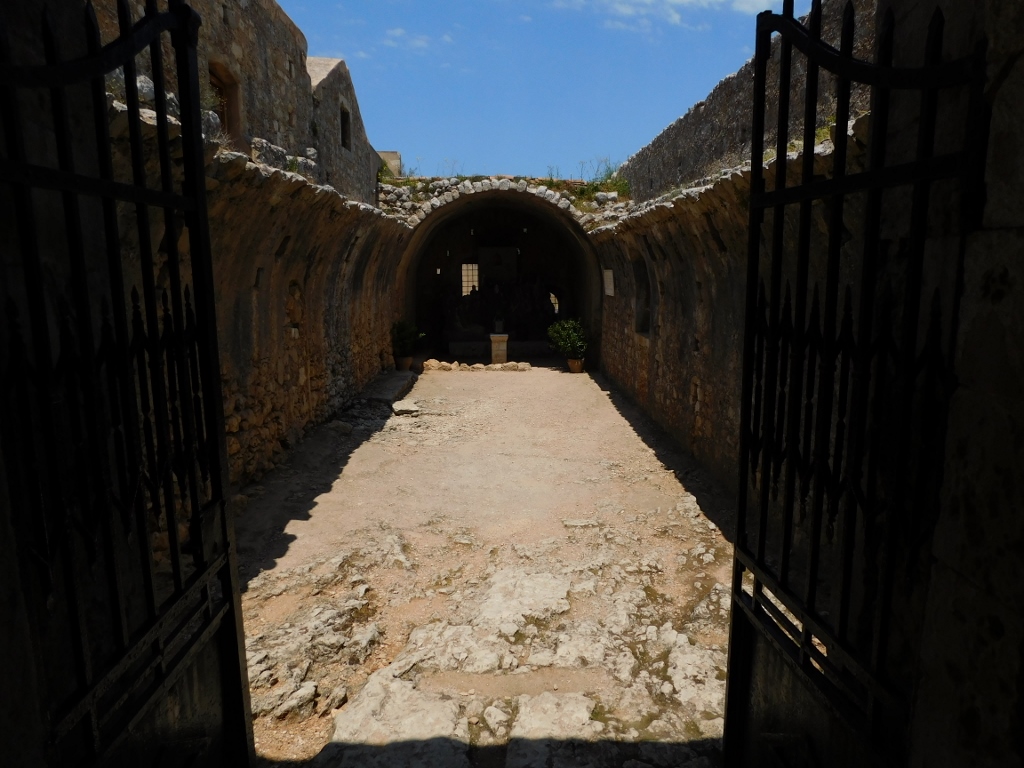 Arkadi Monastery, Powder Magazine
Arkadi Monastery, Powder Magazine
It is precisely on account of all of this that the Holy Monastery of Arkadi has over time become a national symbol, not only on Crete, but throughout Greece, conveying the idea of self-sacrifice, heroism and freedom.
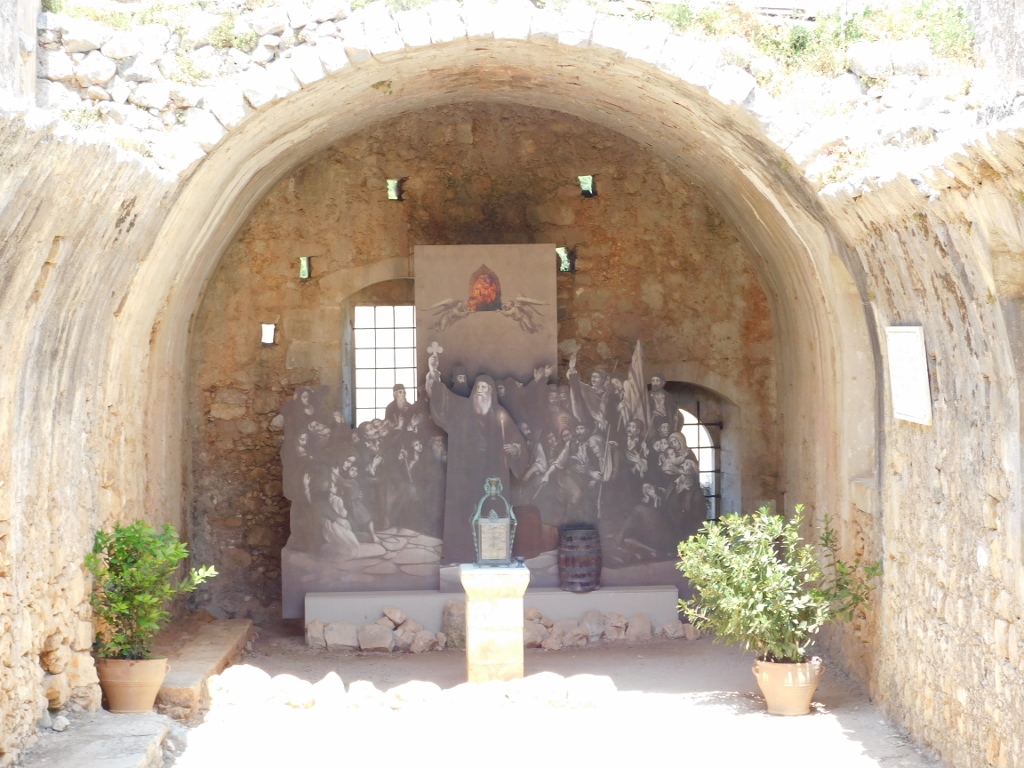 Arkadi Monastery, Powder Magazine, a detail
Arkadi Monastery, Powder Magazine, a detail
Then I returned to the churchyard and there I took photos of different elements and details.
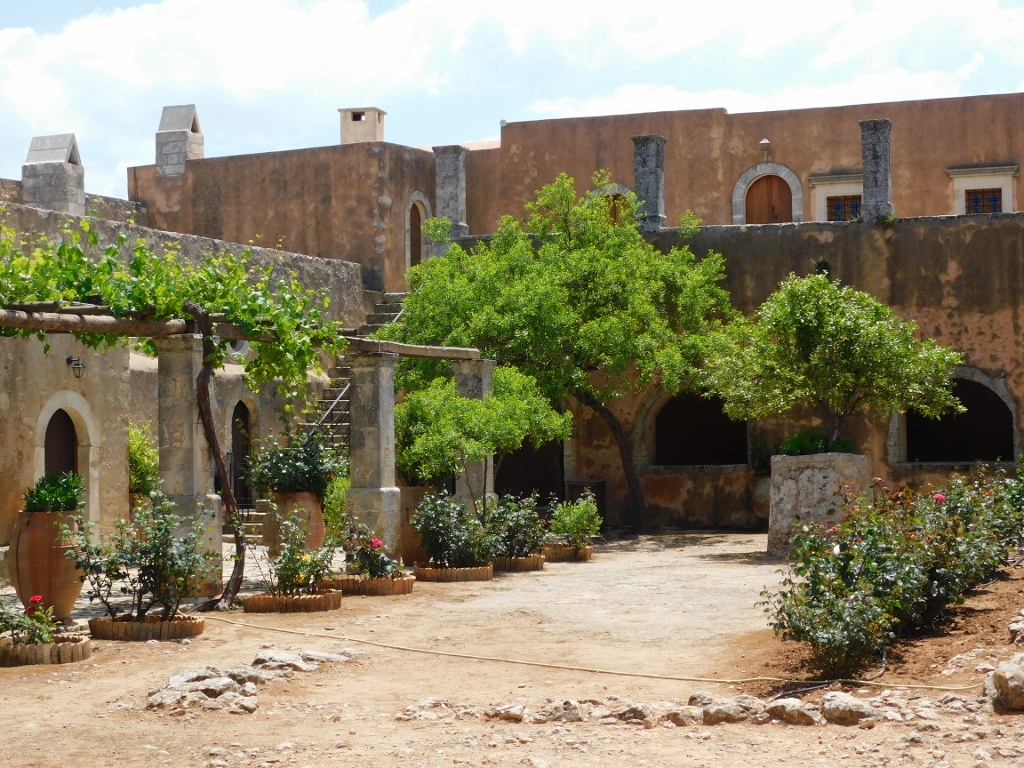 Arkadi Monastery, a section of the churchyard
Arkadi Monastery, a section of the churchyard
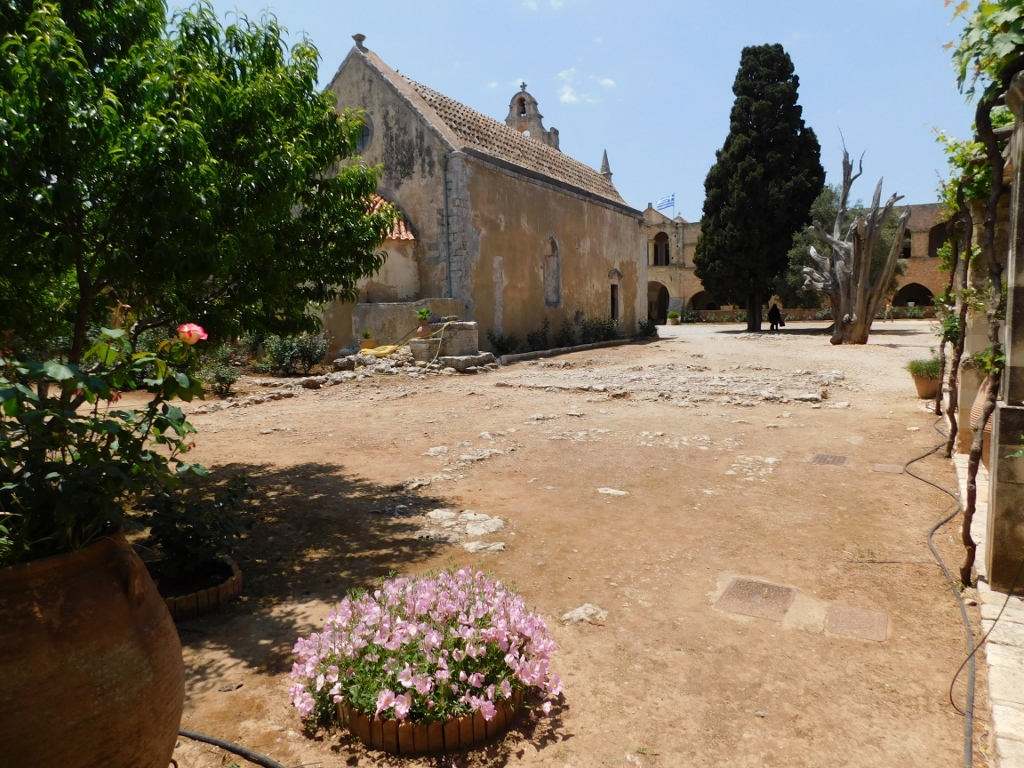 Arkadi Monastery, a section of the churchyard
Arkadi Monastery, a section of the churchyard
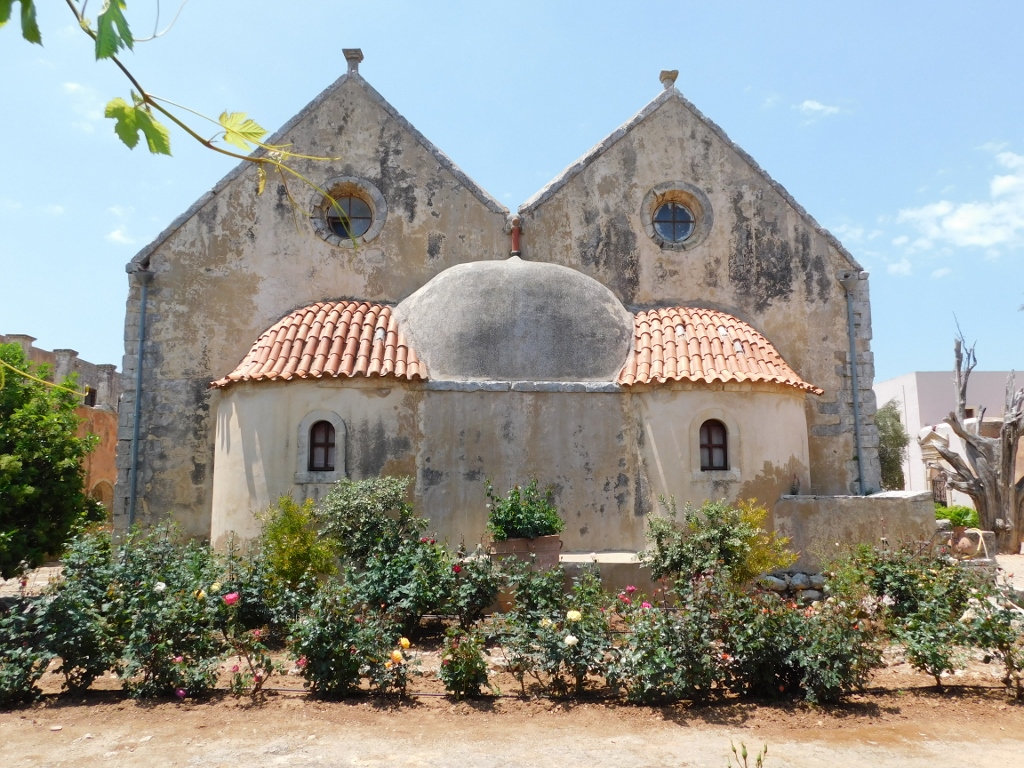 Arkadi Monastery, view at the back section of the church
Arkadi Monastery, view at the back section of the church
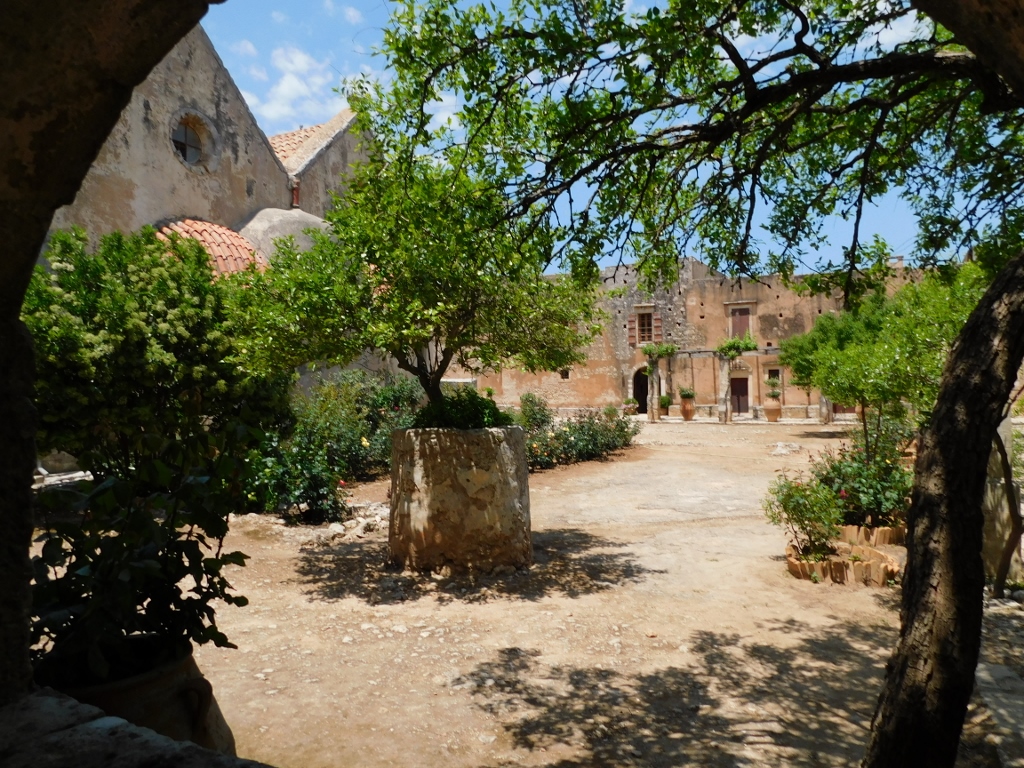 Arkadi Monastery, a section of the churchyard
Arkadi Monastery, a section of the churchyard
On the south side of the churchyard, it is possible to see an arched wall. Behind the arches, there is a vaulted passage from where the monks’ cells are entered.
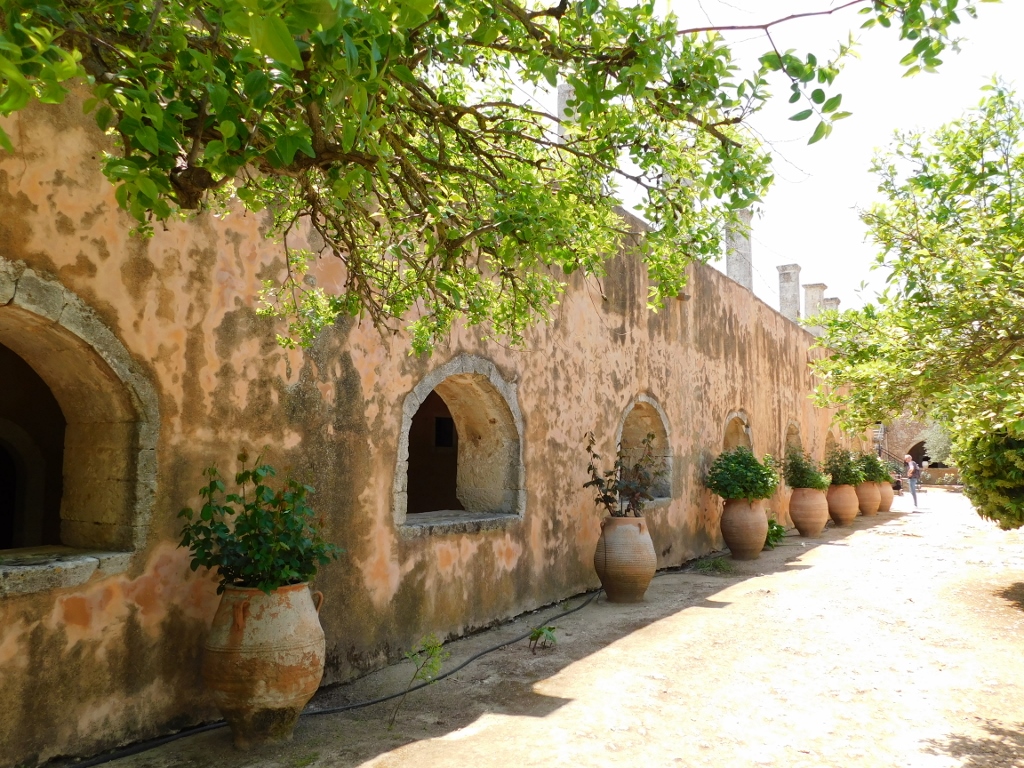 Arkadi Monastery, a section of the churchyard
Arkadi Monastery, a section of the churchyard
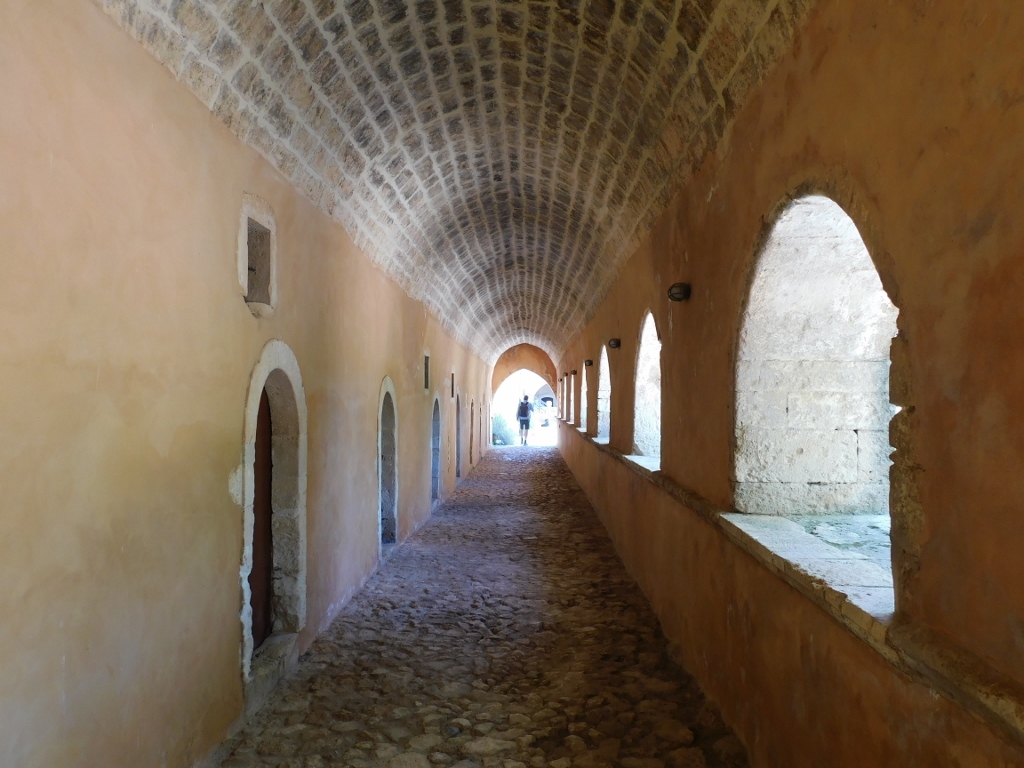 Arkadi Monastery, passage by the monks’ cells
Arkadi Monastery, passage by the monks’ cells
And finally, in the end I climbed to the upper floor above the West Gate and from there I continued to admire the Katholikon of Arkadi Monastery. Even when I went down to the churchyard again, I could not resist and had to take a couple of more photos of this exceptionally beautiful church.
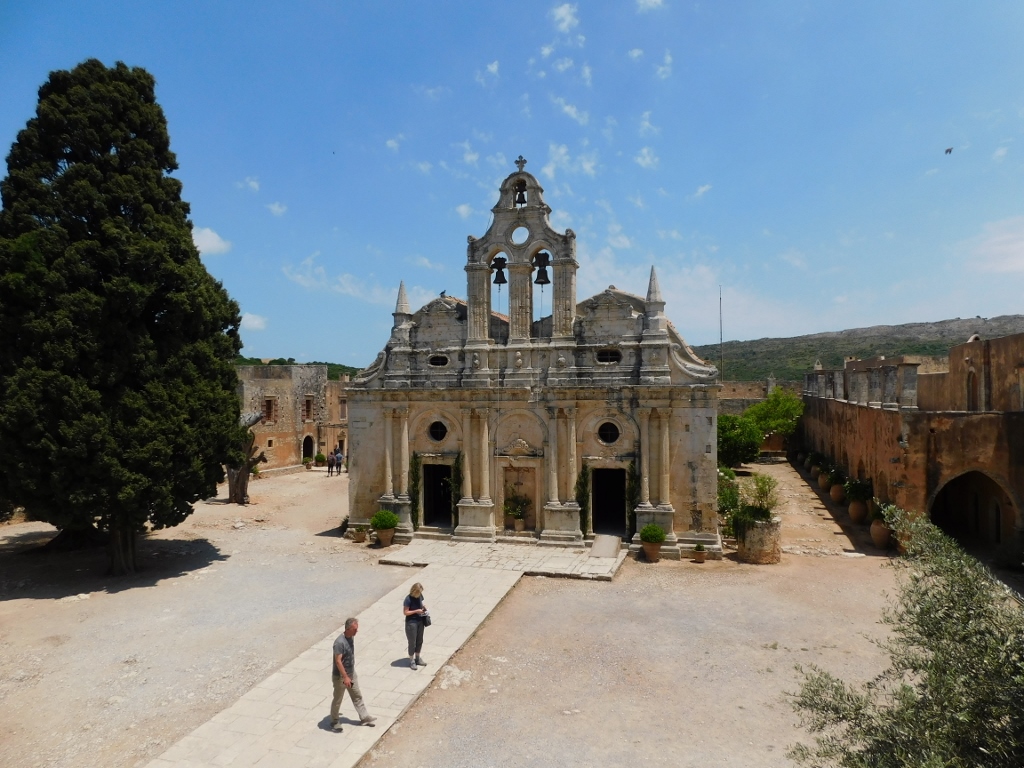 Arkadi Monastery, the Katholikon
Arkadi Monastery, the Katholikon
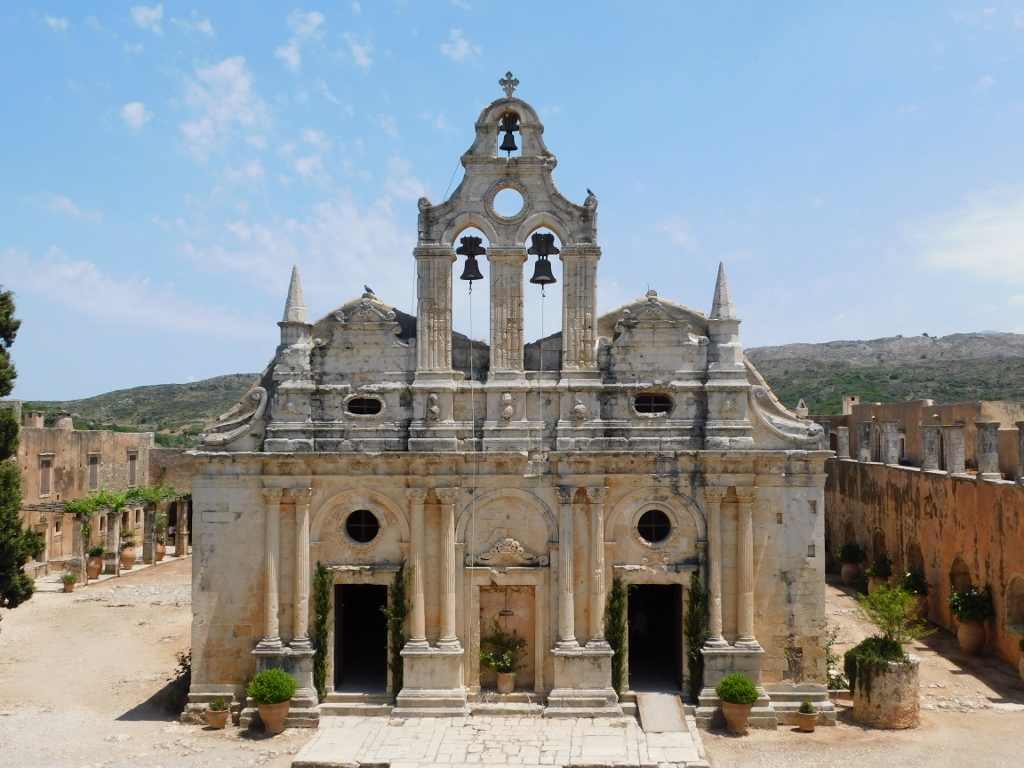 Arkadi Monastery, the Katholikon
Arkadi Monastery, the Katholikon
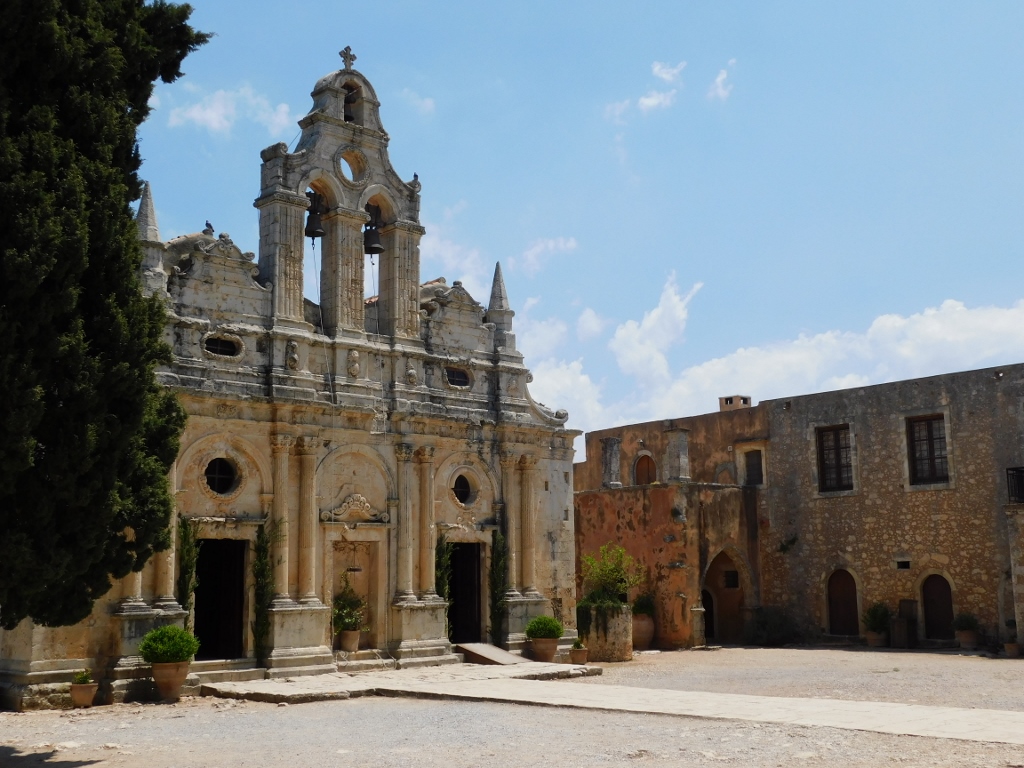 Arkadi Monastery, the Katholikon
Arkadi Monastery, the Katholikon
Let me just mention that the monastery is situated at 500 m a.s.l. Close to it there is Arkadi Gorge where one can also go hiking. I did not have any such plans here, although I was exceptionally happy with my on-the-spot improvisation and the luck that had struck me and brought me to Arkadi Monastery. But, I thought this was enough, so I simply got into the car and continued farther in the direction of the south coast.
While driving on through the interior of Crete, I just kept on admiring this exceptionally beautiful island that I think does not have the fame it deserves. Yes, there is Knossos, the Minoan civilisation and the museum... Yes, there are the beaches and the stunning clear sea... But... I could not decide what I liked more here. On this day, I just confirmed what I had become aware of when I went to Samaria Gorge and when I drove to Elafonisi Beach – the landscapes in the interior of Crete are spectacular!
 Interior of Crete
Interior of Crete
At one moment I had quite a fine view at the mountain range Psiloritis that also includes Mount Ida with the highest summit at 2456 m.
 Interior of Crete
Interior of Crete
This mountain is quite famous thanks to the Ancient Greek mythology. Namely, Mount Ida was the holy mountain for Goddess Rhea and since her husband, Cronus, was prone to eating his own children, she withdrew here in order to give birth to Zeus, while giving her husband a piece of stone wrapped up in diapers and so Zeus survived and spent his childhood on Crete.
Today, it is possible to get to a cave on Mount Ida which is said to be exactly the one where Zeus was born and that cave is called Idaean Cave or Ideon Antron. However, there are also other versions of the Ancient Greek legends and the most popular one of them says that the cave was in fact in the east part of Crete, on Lasithi plateau. That other cave is called Psychro Cave and many believe that it was in fact the mythical Diktaean Cave or Diktaion Andron. Be as it may, there are roads to both of the caves, although it seems to me that the one in east Crete, Psychro Cave, is more popular and commercial, as well as more impressive.
I did not have any intention of chasing caves, but I could still admire Mount Ida from afar.
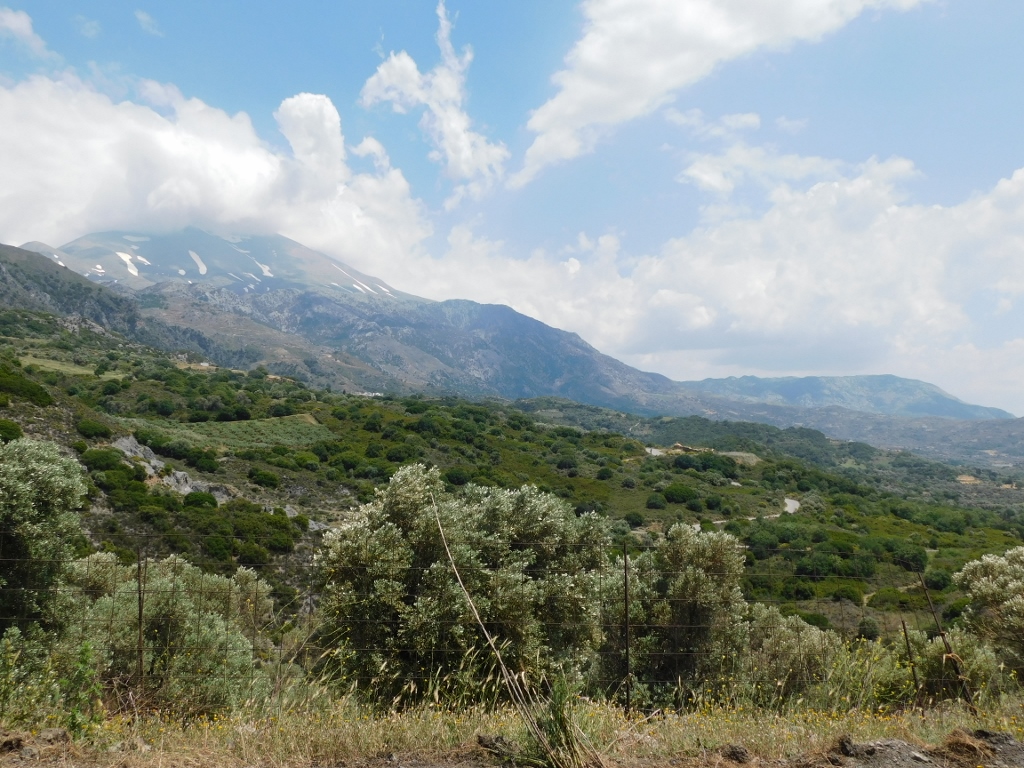 Interior of Crete
Interior of Crete
Soon I descended from the mountain slopes into a valley and then my GPS device showed that I should move onto a local road in order to get to my next destination. I did not mind – the road and the surroundings were very lovely.
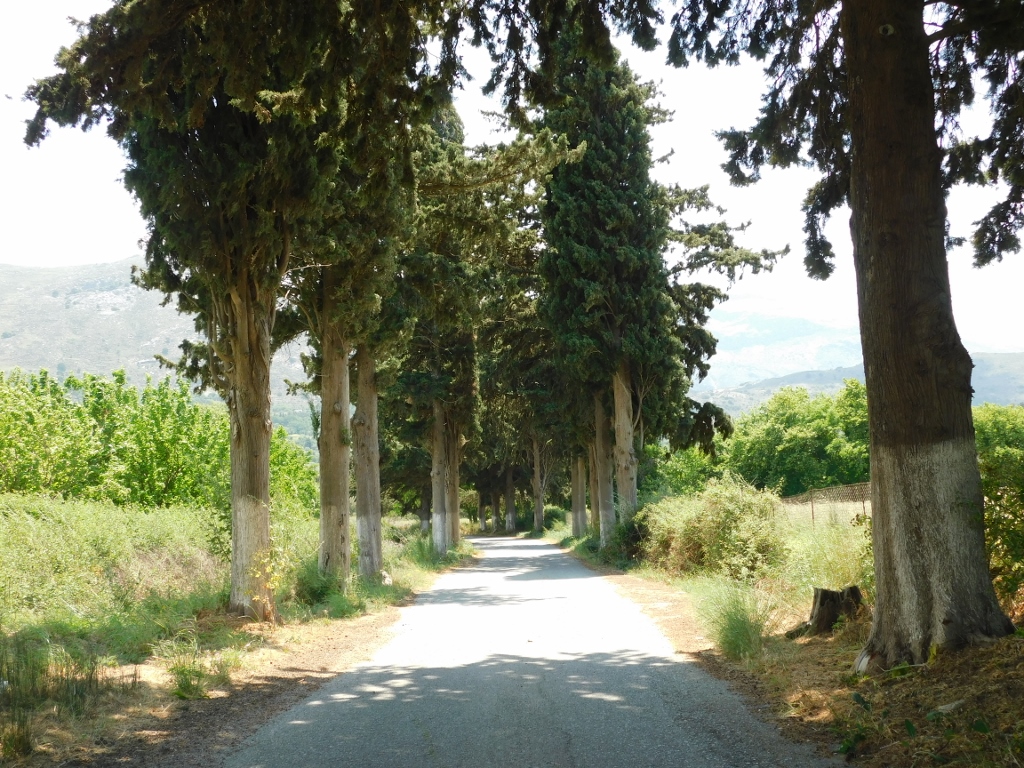 Interior of Crete
Interior of Crete
This next destination was village Amari which also renders the name to this entire fertile valley. I can’t remember any longer, but I do think that the owner of the hotel in Rethimno recommended to me to come here because there is an interesting Venetian bell tower on one of the elevations in the middle of the village. Well, ok. Why not? I parked the car in an alley and then I walked up towards the tower.
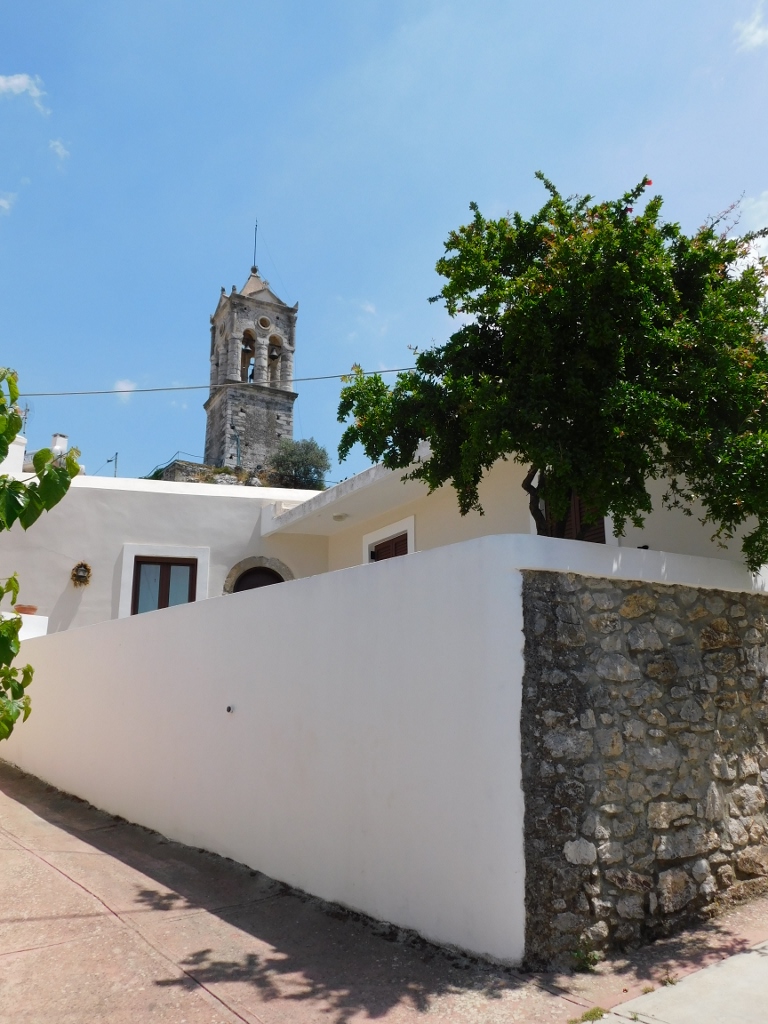 Amari village, a detail
Amari village, a detail
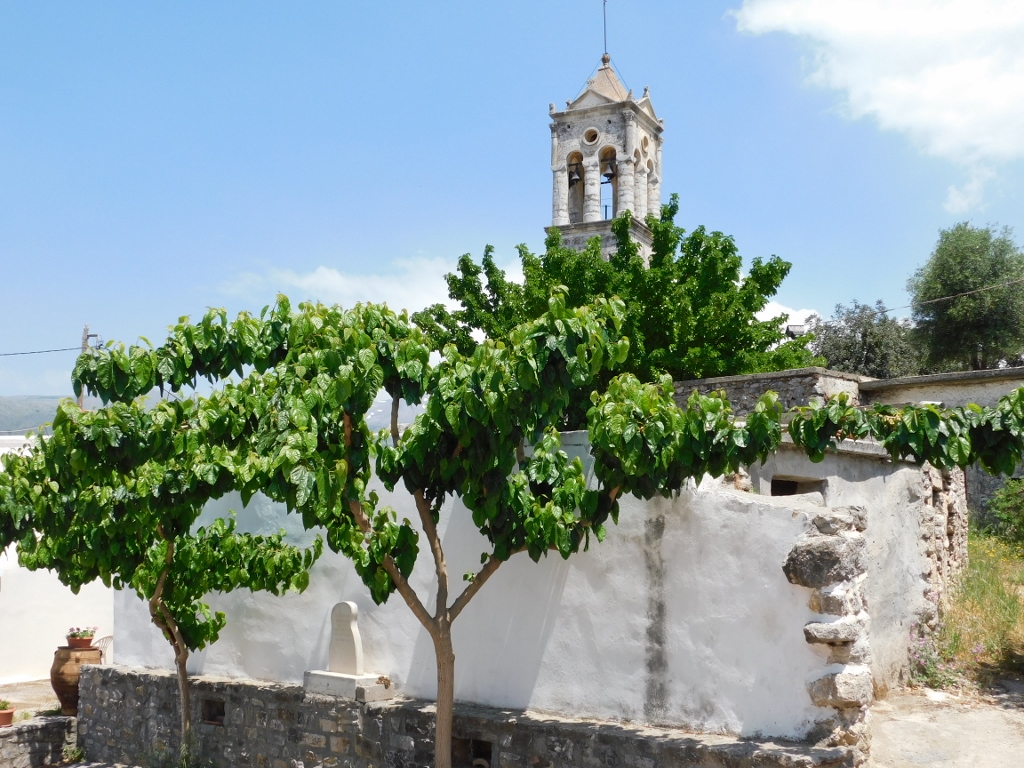 Amari village, a detail
Amari village, a detail
Although I did try and walked around, I could not find the passage to the tower itself and in the end I did not care much. I managed to get to a place from where there was a wonderful north view.
 North view from Amari village
North view from Amari village
Still, Amari village is not uninteresting. If somebody has more time than what I had at disposal during my brief visit, there are a couple of places of interest. One of them is linked to the Memorial Olive Grove. Namely, the entire Amari valley is famous for olive cultivation and this particular olive grove has been declared a natural monument. For instance, one olive tree (marked on the Google Map as the Monumental Olive Tree of Monastiraki), which is believed to be over 3000 years old (!!!), has the circumference of the tree trunk of 18.80 m.
As for this “Monastiraki” in the name of the olive tree, there is a nearby village called like that, as well as an archaeological site of Minoan Monastiraki that is some 2.5 km east of the centre of Amari village. It is presumed that this Minoan settlement was developed by the rulers of Phaistos when they spread towards the north and Amari valley.
In any case, I just got into the car and moved on in the general direction of the south coast of Crete in the meantime realising I should fill up the car tank. While paying attention to the signs by the road, I noticed a sign for a restaurant. I thought to myself: “Why not?,” and then I stopped there. First I thought I should just drink something to refresh, but the restaurant’s terrace was full of flowers and the mother and daughter who worked there were very nice, so I figured I could help them a little with their business and decided on the spot to have a lunch here.
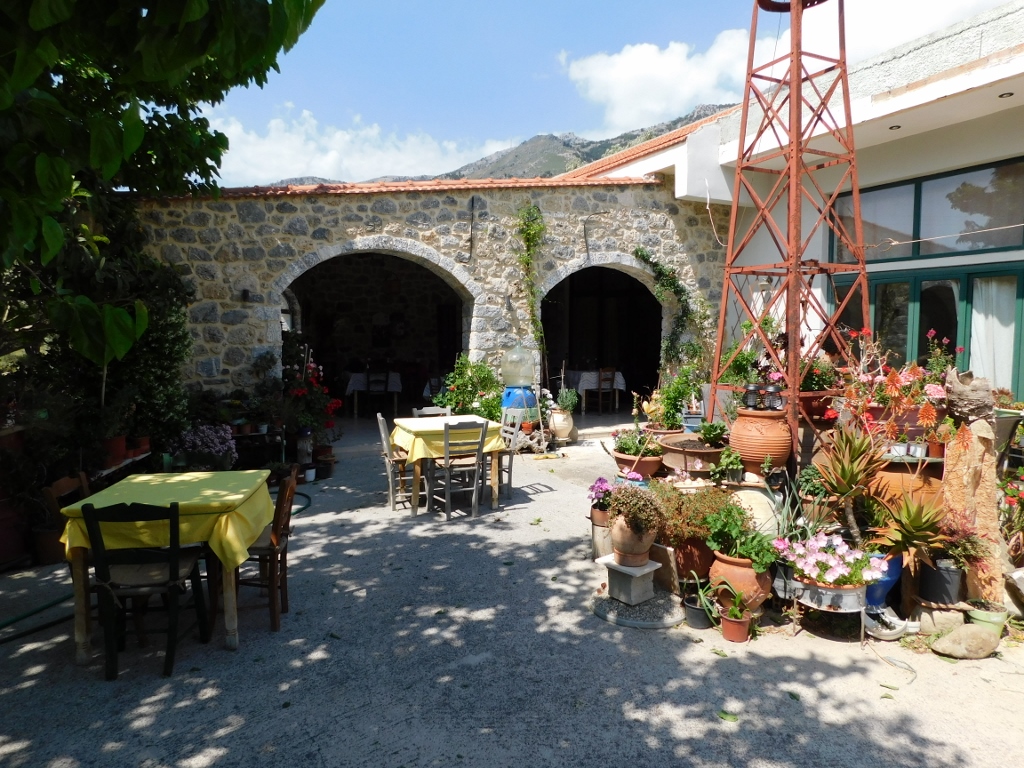 Terrace of a restaurant by the road
Terrace of a restaurant by the road
Well, before coming to Crete, I generally decided that here I would eat only the food that comes from the sea. I cannot do it so easily in my landlocked country. I mean, I can, but all of that is imported, while here it should be the freshest possible. However, here I was, in the middle of hills and mountains, with no sea in sight. So, I decided to order moussaka. I was also given different small side dishes and a very nice dessert, and was even offered local brandy, but I really never drink when I drive, so the last one was out. As for the moussaka, it was not bad, although as a “serious cook” I was fully aware that it was made a day or maybe even two beforehand and was now just warmed up. I basically did not mind this, but... It was, just like the other dishes I was offered, incredibly salty and I realised this in full only later when I could not digest it, while constantly craving for more water. I know that restaurants are often prone to using too much salt in order to encourage the guests to order more drinks, since the bulk of the profit comes from the drinks, but this was really too much. Be as it may, I had problems for the next 5-6 hours to get back to the feeling of lightness in my stomach.
When all of this was over, I just repeated to myself that I would not eat any “continental” food while I was here. After all, as I’ve mentioned before, I also come from the Balkans and so I’m quite familiar with dishes such as moussaka. Moreover, I think that the recipe for aubergine moussaka which I inherited from my mom is unsurpassed. One does have to fiddle a bit more, but the result is – sublime!
Here is the recipe, as well as the photograph:
AUBERGINE MOUSSAKA
- 300 g of ground meat (I usually use mixture of pork and beef, but it is also possible to use only beef)
- 1 large onion
- 3-4 cloves of garlic
- parsley
- salt
- pepper
- 600 g of aubergines
- flour for frying
- salt
- 3-4 eggs
- 2 dl milk
Finely chop the onion and fry it a little. When the onion softens, add the finely chopped garlic and then also the ground meat. This should be seasoned with salt and pepper, while also adding chopped parsley. Fry a little more and then leave it on the side.
The aubergines are cut into round and not too thick slices and then they should be blanched in salted water (you boil them for just some 20 seconds). Take them out and leave on the side to cool. Then you fry them using batter (first you put the slices in flour and then into beaten egg or two with salt).
Cover the dish that can go into an oven with oil and then arrange in it: the fried aubergines, then meat, then aubergines and so on until you have used all up. Then you pour over this a mixture of beaten eggs and milk (if you have any beaten egg mixture from the frying, use this by all means and then add as necessary a couple of more eggs). You can also add some more parsley.
Bake it at 180 degrees C for about half an hour.
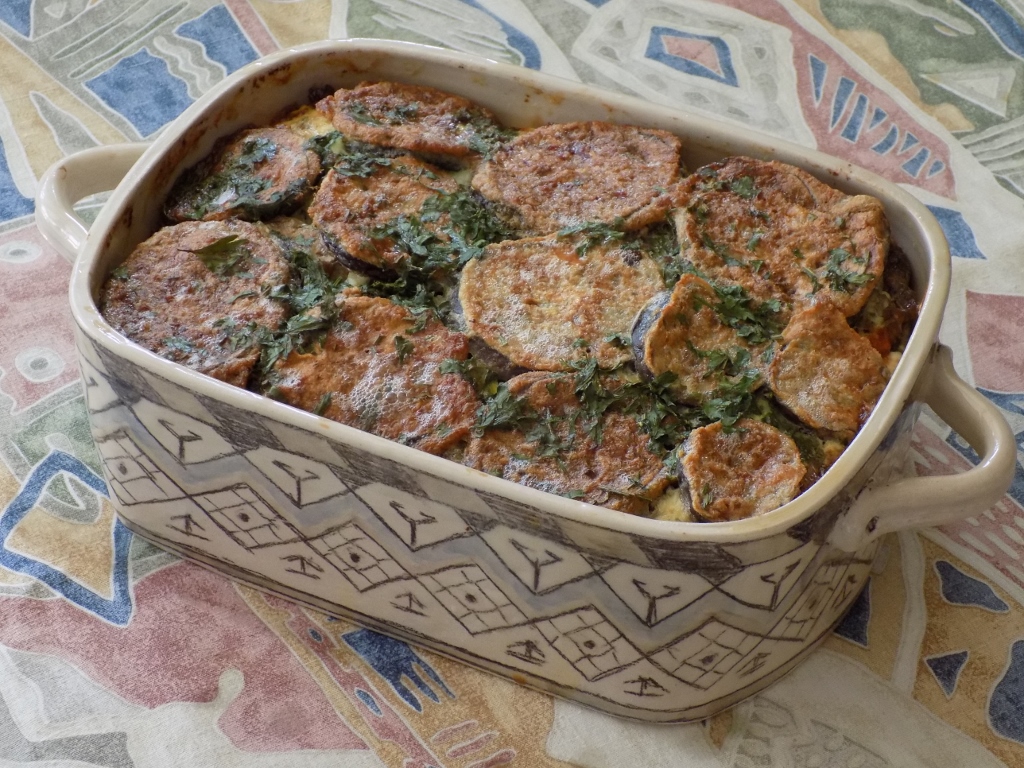 Aubergine moussaka prepared in a pottery dish I made myself
Aubergine moussaka prepared in a pottery dish I made myself